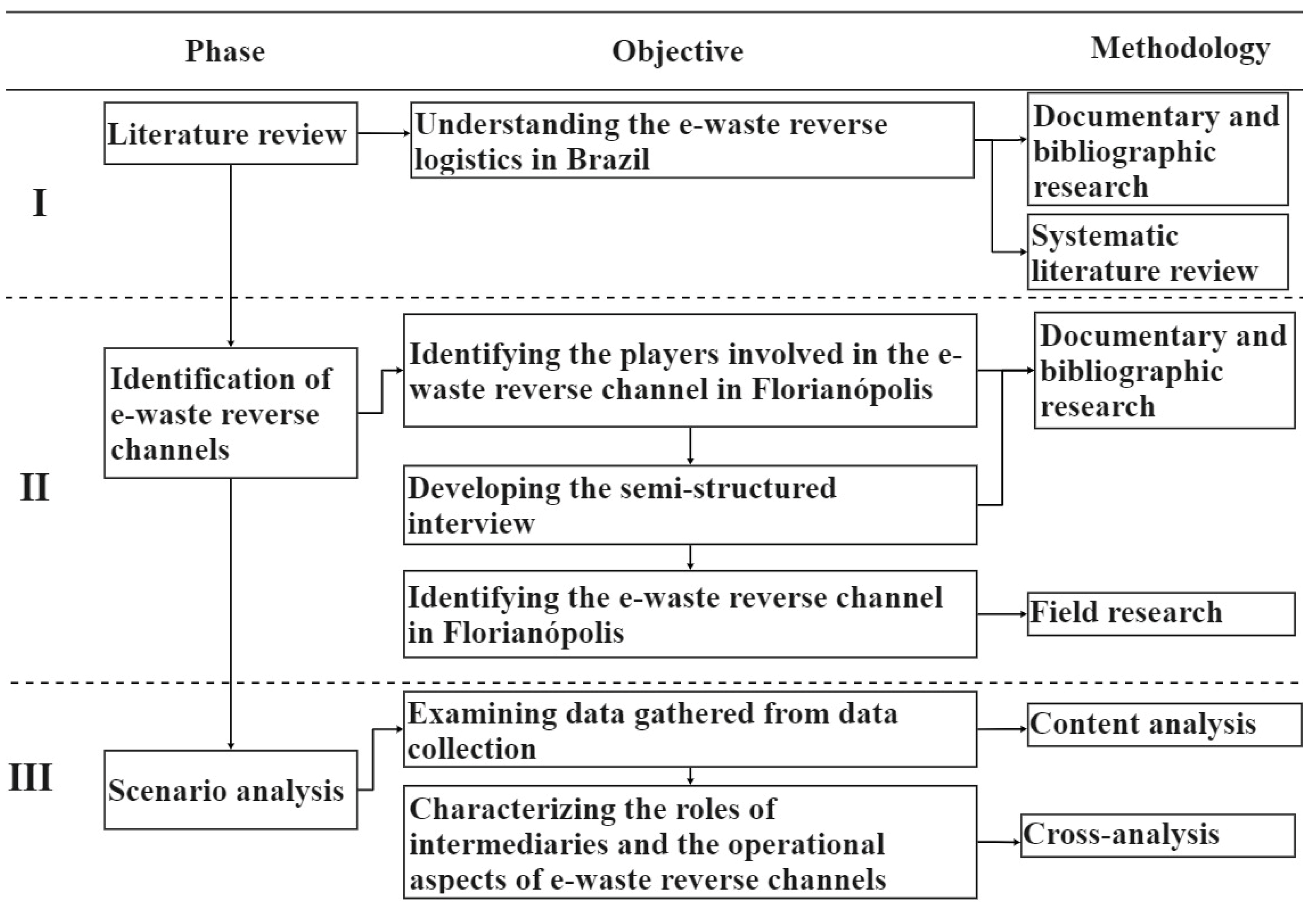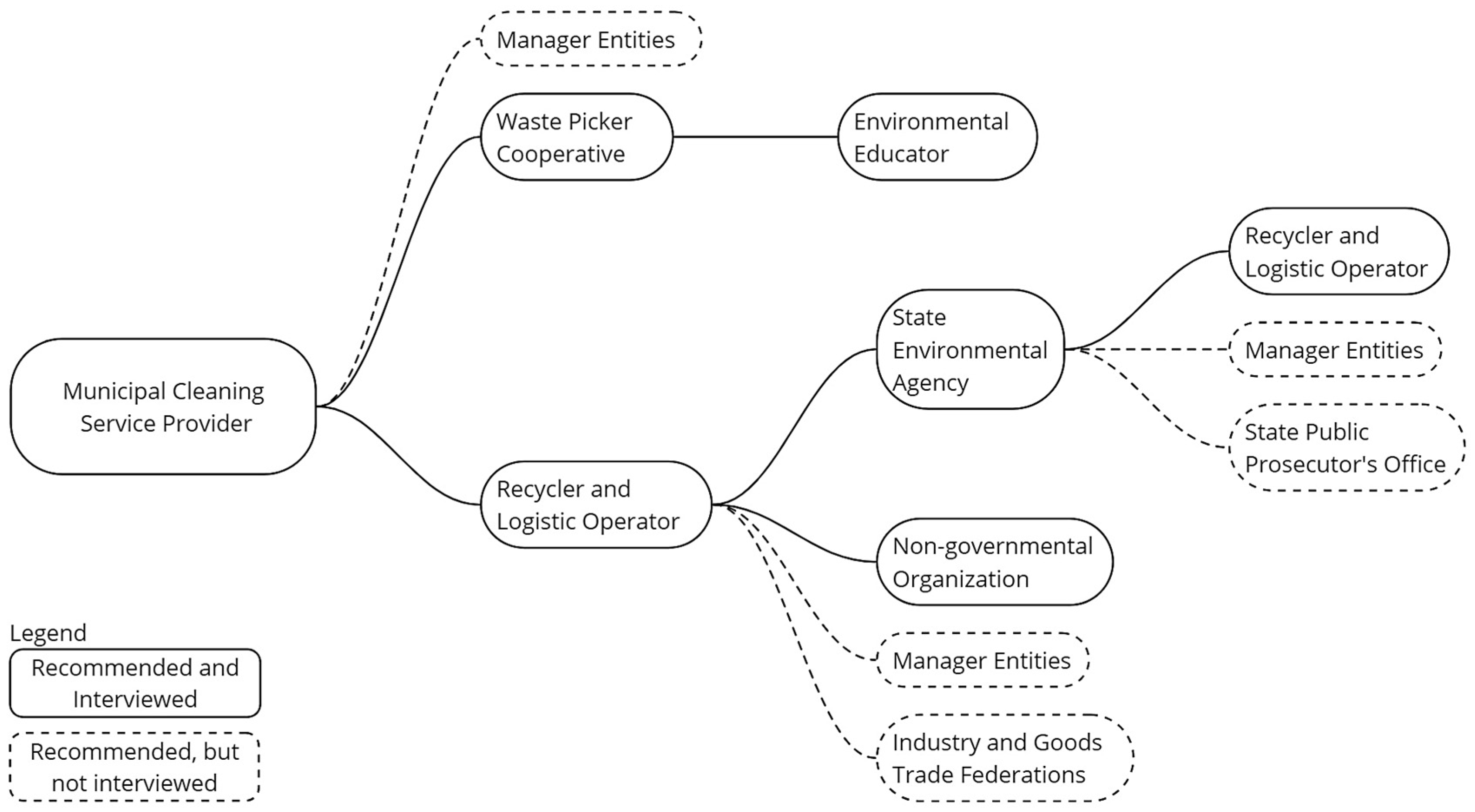Brazil’s Formal E-Waste Recycling System: From Disposal to Reverse Manufacturing
Abstract
:1. Introduction
2. Methodology
3. Literature Review
3.1. Waste Electrical and Electronic Equipment
3.2. Reverse Channel
3.3. E-Waste Flow in Brazil
3.4. Environmental Regulations for E-Waste in Brazil
4. Results and Discussion
4.1. Collaboration among Stakeholders of E-Waste Reverse Channels
4.2. Organizational Setup of E-Waste Reverse Logistics
4.3. Operational Aspects of E-Waste Reverse Channels
5. Perspectives
6. Conclusions
Author Contributions
Funding
Institutional Review Board Statement
Informed Consent Statement
Data Availability Statement
Acknowledgments
Conflicts of Interest
References
- de Oliveira Neto, G.C.; de Jesus Cardoso Correia, A.; Schroeder, A.M. Economic and Environmental Assessment of Recycling and Reuse of Electronic Waste: Multiple Case Studies in Brazil and Switzerland. Resour. Conserv. Recycl. 2017, 127, 42–55. [Google Scholar] [CrossRef]
- Forti, V.; Baldé, C.P.; Kuehr, R.; Bel, G. The Global E-Waste Monitor 2020: Quantities, Flows and the Circular Economy Potencial. Available online: https://ewastemonitor.info/wp-content/uploads/2020/11/GEM_2020_def_july1_low.pdf (accessed on 4 April 2022).
- Balde, C.P.; Forti, V.; Gray, V.; Kuehr, R.; Stegmann, P. The Global E-Waste Monitor 2017: Quantities, Flows and Resources; United Nations University (UNU): Bonn, Germany; International Telecommunication Union (ITU): Geneva, Switzerland; International Solid Waste Association (ISWA): Vienna, Austria, 2017.
- IBGE, Instituto Brasileiro de Geografia e Estatística (Brazilian Institute of Geography and Statistics). Estimativas da População Residente no Brasil. Available online: https://www.ibge.gov.br/estatisticas/sociais/populacao/9103-estimativas-de-populacao.html?edicao=25272&t=resultados (accessed on 26 March 2020).
- Brazil, Decree No 10,240, of 12 February 2020. Regulates Law No 12,305/2010 and Complements the Decree No 9177/2017. Available online: http://www.planalto.gov.br/ccivil_03/_ato2019-2022/2020/decreto/D10240.htm (accessed on 27 April 2020).
- Brazil, Brazilian Policy on Solid Waste. Law No. 12305, of 2 August 2010. Institutes the National Policy on Solid Waste; Alters Law No. 9605 of 12 February 1998; and Makes Other Provisions. Available online: http://www.planalto.gov.br/ccivil_03/_ato2007-2010/2010/lei/l12305.htm (accessed on 27 April 2020).
- Ginter, P.M.; Starling, J.M. Reverse Distribution Channels for Recycling. Calif. Manag. Rev. 1978, 20, 72–82. [Google Scholar] [CrossRef]
- IBGE, Instituto Brasileiro de Geografia e Estatística (Brazilian Institute of Geography and Statistics). Informações Sobre Municípios e Estados do Brasil. Available online: https://cidades.ibge.gov.br/brasil/sc/florianopolis/panorama (accessed on 26 March 2020).
- Baldissarelli, A.; Lopes, C.Q.; Orofino, F.V.G.; Martins, G.C. Considerando Mais o Lixo, 2nd ed.; Copiart: Florianópolis, Brazil, 2009; ISBN 9788599554180. [Google Scholar]
- PMF, Prefeitura Municipal de Florianópolis (City Hall of Florianópolis). PMF Investiu R$ 10 Mihões em Coleta Seletiva Para Acelerar Metas Lixo Zero. Available online: http://www.pmf.sc.gov.br/noticias/index.php?pagina=notpagina¬i=22693 (accessed on 7 March 2021).
- Bardin, L. Análise de Conteúdo, 1st ed.; Edições 70: São Paulo, Brazil, 2016; ISBN 978-85-62938-04-7. [Google Scholar]
- Souza, R.G. E-Waste Situation and Current Practices in Brazil. In Handbook of Electronic Waste Management; Elsevier: São José dos Campos, Brazil, 2020; pp. 377–396. ISBN 9780128170304. [Google Scholar]
- Islam, M.T.; Huda, N. Reverse Logistics and Closed-Loop Supply Chain of Waste Electrical and Electronic Equipment (WEEE)/E-Waste: A Comprehensive Literature Review. Resour. Conserv. Recycl. 2018, 137, 48–75. [Google Scholar] [CrossRef]
- SNIS, Sistema Nacional de Informações sobre Saneamento (Brazilian National System for Water and Sanitation Data). Diagnóstico do Manejo de Resíduos Sólidos Urbanos. Available online: https://app.powerbi.com/view?r=eyJrIjoiNGVkYTRiZTktMGUwZS00OWFiLTgwNWYtNGQ3Y2JlZmJhYzFiIiwidCI6IjJiMjY2ZmE5LTNmOTMtNGJiMS05ODMwLTYzNDY3NTJmMDNlNCIsImMiOjF9 (accessed on 18 April 2020).
- MTE, Ministério do Trabalho e Emprego (Ministry of Labor and Employment). Relação Anual de Informações Sociais. Available online: https://portalfat.mte.gov.br/relacao-anual-de-informacoes-sociais-rais/ (accessed on 15 April 2020).
- Ottoni, M.; Dias, P.; Xavier, L.H. A Circular Approach to the E-Waste Valorization through Urban Mining in Rio de Janeiro, Brazil. J. Clean. Prod. 2020, 261, 120990. [Google Scholar] [CrossRef]
- Kumar, A.; Holuszko, M.; Espinosa, D.C.R. E-Waste: An Overview on Generation, Collection, Legislation and Recycling Practices. Resour. Conserv. Recycl. 2017, 122, 32–42. [Google Scholar] [CrossRef]
- de Souza, R.G.; Clímaco, J.C.N.N.; Sant’Anna, A.P.; Rocha, T.B.; Valle, R.d.A.B.D.; Quelhas, O.L.G. Sustainability Assessment and Prioritisation of E-Waste Management Options in Brazil. Waste Manag. 2016, 57, 46–56. [Google Scholar] [CrossRef]
- Echegaray, F. Consumers’ Reactions to Product Obsolescence in Emerging Markets: The Case of Brazil Fabi A. J. Clean. Prod. 2016, 134, 191–203. [Google Scholar] [CrossRef]
- Rodrigues, A.C.; Boscov, M.E.G.; Günther, W.M.R. Domestic Flow of E-Waste in São Paulo, Brazil: Characterization to Support Public Policies. Waste Manag. 2020, 102, 474–485. [Google Scholar] [CrossRef]
- Ghisolfi, V.; Diniz Chaves, G.D.L.; Ribeiro Siman, R.; Xavier, L.H. System Dynamics Applied to Closed Loop Supply Chains of Desktops and Laptops in Brazil: A Perspective for Social Inclusion of Waste Pickers. Waste Manag. 2017, 60, 14–31. [Google Scholar] [CrossRef]
- Fuller, D.A. Recycling Consumer Solid Waste: A Commentary on Selected Channel Alternatives. J. Bus. Res. 1978, 6, 17–31. [Google Scholar] [CrossRef]
- Brown, J.R.; Lusch, R.F.; Nicholson, C.Y. Power and Relationship Commitment: Their Impact on Marketing Channel Member Performance. J. Retail. 1995, 71, 363–392. [Google Scholar] [CrossRef]
- Hofmann, E.; Hartl, B.; Gangl, K.; Hartner-Tiefenthaler, M.; Kirchler, E. Authorities’ Coercive and Legitimate Power: The Impact on Cognitions Underlying Cooperation. Front. Psychol. 2017, 8, 5. [Google Scholar] [CrossRef]
- Rosenbloom, B. Multi-Channel Strategy in Business-to-Business Markets: Prospects and Problems. Ind. Mark. Manag. 2007, 36, 4–9. [Google Scholar] [CrossRef]
- Mehta, R.; Larsen, T.; Rosenbloom, B. The Influence of Leadership Style on Co-Operation in Channels of Distribution. Int. J. Phys. Distrib. Logist. Manag. 1996, 26, 32–59. [Google Scholar] [CrossRef]
- Giglio, E.; Pedro, F.; Cagica, L.; Xara, D. The Governance of E-Waste Recycling Networks: Insights from São Paulo City. Waste Manag. 2023, 161, 10–16. [Google Scholar] [CrossRef]
- Vieira, B.d.O.; Guarnieri, P.; e Silva, L.C.; Alfinito, S. Prioritizing Barriers to Be Solved to the Implementation of Reverse Logistics of E-Waste in Brazil under a Multicriteria Decision Aid Approach. Sustainability 2020, 12, 4337. [Google Scholar] [CrossRef]
- ABDI, Agência Brasileira de Desenvolvimento Industrial (Brazilian Agency on Industrial Development). Logística Reversa de Equipamentos Eletroeletrônicos: Análise de Viabilidade Técnica e Econômica. Available online: https://sinir.gov.br/images/sinir/logistica_reversa/evte_eletroeletronico (accessed on 7 March 2020).
- Alves, R.; Ferreira, K.L.A.; Lima, R.d.S.; Moraes, F.T.F. An Action Research Study for Elaborating and Implementing an Electronic Waste Collection Program in Brazil. Syst. Pract. Action Res. 2019, 34, 91–108. [Google Scholar] [CrossRef]
- Noy, C. Sampling Knowledge: The Hermeneutics of Snowball Sampling in Qualitative Research. Int. J. Soc. Res. Methodol. 2008, 11, 327–344. [Google Scholar] [CrossRef]
- Vargas, D.B.; de Souza Campos, L.M.; Luna, M.M.M. E-Waste Reverse Logistics for Household Products and Its Regulation: Advances in Brazil. In Springer Proceedings in Mathematics & Statistics; Springer: Berlin/Heidelberg, Germany, 2022; pp. 259–273. [Google Scholar]
- ABREE, Agência Brasileira de Desenvolvimento Industrial (Brazilian Agency on Industrial Development). Relatório Anual de Desempenho Do Sistema de Logística Reversa de Eletroeletrônicos e Seus Componentes de Uso Doméstico. Available online: https://abree.org.br/relatorio-anual (accessed on 4 August 2023).
- GAP, Grupo de Acompanhamento de Performance (Performance follow-up group). Relatório Anual de Acompanhamento e Performance da Logística Reversa de Produtos Eletroeletrônicos de Uso Doméstico e Seus Componentes. Available online: https://portal-api.sinir.gov.br/wp-content/uploads/2022/12/Relatorio_Anual_de_Desempenho_ABREE_ano-referencia-2021.pdf (accessed on 4 August 2023).
- Cipriano, T.A.R.P. O Conceito de Consumidor No Direito Brasileiro. Rev. Direito Consum. 2021, 133, 357–384. [Google Scholar]
- Caiado, N.; Guarnieri, P.; Xavier, L.H.; de Lorena Diniz Chaves, G. A Characterization of the Brazilian Market of Reverse Logistic Credits (RLC) and an Analogy with the Existing Carbon Credit Market. Resour. Conserv. Recycl. 2017, 118, 47–59. [Google Scholar] [CrossRef]
- Moura, J.M.B.M.; Gohr Pinheiro, I.; Lischeski, D.; Valle, J.A.B. Relation of Brazilian Institutional Users and Technical Assistances with Electronics and Their Waste: What Has Changed? Resour. Conserv. Recycl. 2017, 127, 68–75. [Google Scholar] [CrossRef]
- PMF, Prefeitura Municipal de Florianópolis (City Hall of Florianópolis). Valorização de Resíduos Sólidos. Available online: https://www.pmf.sc.gov.br/entidades/comcap/index.php?cms=valorizacao+de+residuos+solidos&menu=0 (accessed on 24 August 2023).





| Company | Stakeholder Description | Contribution to the Research | Interview Length and Date |
|---|---|---|---|
| Municipal Cleaning Service | Senior engineer in the waste collection sector | Contributed to the development and signing of the cooperation agreement for e-waste reverse logistics between the Municipal Cleaning Service and ABREE (manager entity) | 45 min interview + 45 min field visit (16 December 2021) |
| Waste Picker Cooperative | Head of the association | The largest formal waste picker association in the city | 50 min interview + 20 min field visit (11 January 2022) |
| Environmental Educator | Environmental monitor at the city hall | Know-how as an environmental activist, member of environmental education groups, and creates sculptures from e-waste | 50 min interview + 20 min field visit (11 January 2022) |
| Recycler and Logistic Operator | Environmental engineer, founder, and head of the e-waste recycling company | Founder of the largest e-waste reverse logistics company in the Florianópolis region, also contracted by ABREE and approved as a recycler by Green Eletron | 53 min interview (3 February 2022) + 60 min field visit (11 February 22) |
| Non-governmental Organization | Council member of the organization | Member of the organization with the most experience in e-waste reverse logistics | Same interviewee as recycler and logistic operator |
| State Environmental Agency | Head of the state strategic program for waste management and reverse logistics | Founder of the “Penso, Logo Destino (Literally translation to If I think, then I dispose)” Program, which aims to raise awareness and involve consumer in the proper disposal of solid waste | 135 min interview (14 February 22) |
| Reverse Channel Member | Responsibilities According to Regulation |
|---|---|
| Consumer | Dispose of e-waste at the delivery points |
| Manufacturer and importer | Provide appropriate disposal; collaborate with environmental education and the communication plan; finance the reverse logistics system |
| Distributor and retailer | Provide consolidation and collection points; inform consumers of their responsibilities (only retailers); collaborate with environmental education and the communication plan |
| Performance follow-up group | Monitor, support, and supervise the reverse logistics system |
| Manager entities (ABREE and Green Eletron) | Perform reverse logistics actions, being able to hire or subcontract third parties to provide services |
| Waste picker cooperatives, public cleaning services, big generators, and non-governmental and related organizations | They can join the reverse logistics system through a contract with companies or a manager entity |
| Year | 2017 | 2018 | 2019 | 2020 | 2021 | 2022 | 2023 |
|---|---|---|---|---|---|---|---|
| Amount collected (t) | 32 | 24 | 22.5 | 46 | 67 | 55.3 | 102.1 * |
Disclaimer/Publisher’s Note: The statements, opinions and data contained in all publications are solely those of the individual author(s) and contributor(s) and not of MDPI and/or the editor(s). MDPI and/or the editor(s) disclaim responsibility for any injury to people or property resulting from any ideas, methods, instructions or products referred to in the content. |
© 2023 by the authors. Licensee MDPI, Basel, Switzerland. This article is an open access article distributed under the terms and conditions of the Creative Commons Attribution (CC BY) license (https://creativecommons.org/licenses/by/4.0/).
Share and Cite
Vargas, D.B.; Campos, L.M.d.S.; Luna, M.M.M. Brazil’s Formal E-Waste Recycling System: From Disposal to Reverse Manufacturing. Sustainability 2024, 16, 66. https://doi.org/10.3390/su16010066
Vargas DB, Campos LMdS, Luna MMM. Brazil’s Formal E-Waste Recycling System: From Disposal to Reverse Manufacturing. Sustainability. 2024; 16(1):66. https://doi.org/10.3390/su16010066
Chicago/Turabian StyleVargas, Danieli Braun, Lucila Maria de Souza Campos, and Mônica Maria Mendes Luna. 2024. "Brazil’s Formal E-Waste Recycling System: From Disposal to Reverse Manufacturing" Sustainability 16, no. 1: 66. https://doi.org/10.3390/su16010066
APA StyleVargas, D. B., Campos, L. M. d. S., & Luna, M. M. M. (2024). Brazil’s Formal E-Waste Recycling System: From Disposal to Reverse Manufacturing. Sustainability, 16(1), 66. https://doi.org/10.3390/su16010066








